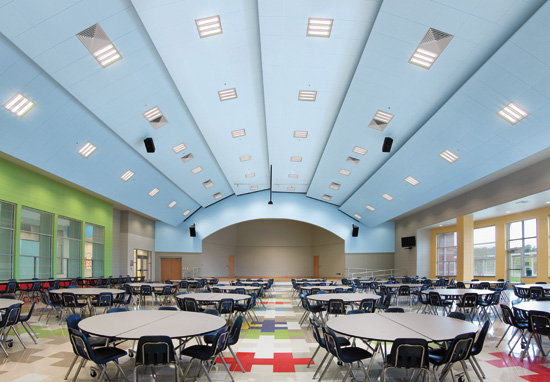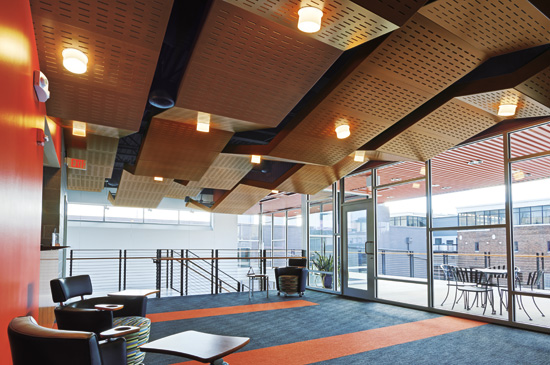Innovations in Acoustical Ceilings for Today’s Flexible Interiors
Material Options for High-Performing Ceilings
How do you specify properly to achieve desired ratings? Let's view four types of ceiling materials: Mineral fiber, fiberglass, wood and metal.
Mineral Fiber Ceilings
Mineral fiber ceilings provide the best combination of sound absorption and sound blocking to optimize acoustics in every space, price, and performance range. High-performing mineral fiber ceilings are good choices where noise from occupants is likely to reach high decibel levels. Use high-performing mineral fiber to control reverberation time. They are recyclable at the end of their useful life and many are certified as USDA BioPreferred products.

Photo courtesy of Armstrong® Commercial Ceilings
High-performing mineral fiber ceilings are good choices where noise from occupants is likely to reach high decibel levels, such as in crowded offices or school cafeterias.

Photo courtesy of Armstrong® Commercial Ceilings
Ceilings with a fiberglass substrate can have high recycled content and specials capability for non-standard sizes.
Fiberglass Ceilings
Fiberglass ceilings provide high sound absorption and are available in standard and high AC configurations. These are a good choice for open plan spaces, but for spaces where many types of work is done an ideal combination of NRC and CAC will assure quality acoustical performance for the building occupants.
The panels come in a large number of standard sizes to mix and match in a variety of layouts for more contemporary designs than traditional ceiling installations.
In addition to the acoustical properties, both mineral fiber and fiberglass ceilings are Class A fire rated, high light reflective, resist mold, mildew, and sag.

Photo courtesy of Armstrong® Commercial Ceilings
Perforations in metal ceilings provide acoustic benefits. Perforations vary in size according to aesthetic needs.
Metal Ceilings
Metal ceilings continue to increase in popularity because of their durability and sleek, contemporary aesthetics. They are offered in a variety of finishes that can impart a very high tech or sophisticated look to a space. These ceiling panels with acoustical fleece backing have an NRC rating of 0.75 and with an added acoustic infill panel, laid behind the ceiling panel, have an NRC rating of 0.90.
Even though it is metal, this type of ceiling can provide both sound absorption and sound blocking. To achieve the acoustic benefits, the panels must be perforated and backed with an acoustic fleece. Perforations vary in size depending on aesthetic appeal, although it is possible today to have extra microperforated panels in which the holes are so small, they are virtually invisible.
Wood Ceilings
Wood ceilings are available in a wide variety of rich, natural finishes and also provide access to the plenum. As with metal, perforated wood panels provide better acoustic performance than non-perforated panels.

Photo courtesy of Armstrong® Commercial Ceilings
Wood ceilings are increasing in popularity because of their beauty and the warm ambiance they impart to a space.
Wood ceiling panels can have an NRC up to 0.80 with an infill panel, and wood planks with similar acoustical treatment can have an NRC of 0.95. In addition to their application in continuous ceilings, both metal and wood panels can also be used in acoustical ceiling clouds, canopies, baffles, and blades.
Linear visuals in wood provide many options that include traditional planks, tapered planks, or easy to install grille with dowel or backer, solid wood or veneers and a variety of plank widths. Traditional planks and grille can be installed in the ceiling, on the wall, or used to create 90-degree angled or curved ceiling-to-wall transitions. Linear wood with acoustical infill can achieve an NRC of up to 0.60, while wood grille can see an NRC of up to 0.85.
Conclusion
The problem of noise pollution inside offices, healthcare settings, and classrooms is pervasive and destructive to productivity, privacy, and learning.
Specifying high-performing acoustical ceiling products with the ideal combination of NRC and CAC is often the best solution an architect can use to address the problem, but one can't just go by those numbers individually; it's the combination of both the NRC and CAC that provide ideal acoustic performance.
Manufacturer's data sheets reveal both the ceiling panel's sound absorbing and sound blocking capacities. Some even provide new classifications, making it easier to assess the combined acoustical performance of a ceiling.
As the studies cited here indicate, poor indoor environmental quality is often caused by the lack of attention to acoustical quality. Getting the acoustics right goes a long way in making the built environment healthy for the occupant, and allow for maximum productivity, privacy and learning.
Endnotes
- http://www.gensler.com/design-thinking/research/the-2013-us-workplace-survey-1
- http://escholarship.org/uc/item/0zm2z3jg#page-3
- http://www.cbe.berkeley.edu/research/acoustic_poe.htm
- http://www.ncbi.nlm.nih.gov/pubmed/12733219
- http://www.armstrong.com/common/c2002/content/files/4250.pdf
 |
Armstrong is the global leader in acoustical ceilings with the broadest portfolio of standard & custom options available, including ceiling and wall systems, plus clouds, canopies, baffles, and all the proven installation systems you need. www.armstrong.com/commceilingsna |








